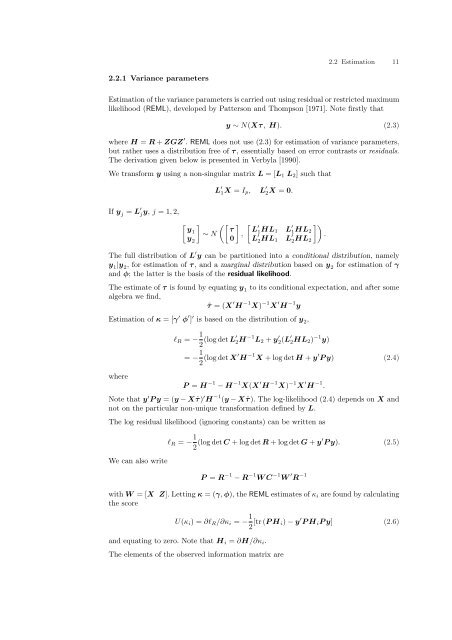ASReml-S reference manual - VSN International
ASReml-S reference manual - VSN International
ASReml-S reference manual - VSN International
- No tags were found...
You also want an ePaper? Increase the reach of your titles
YUMPU automatically turns print PDFs into web optimized ePapers that Google loves.
2.2 Estimation 112.2.1 Variance parametersEstimation of the variance parameters is carried out using residual or restricted maximumlikelihood (REML), developed by Patterson and Thompson [1971]. Note firstly thaty ∼ N(Xτ , H). (2.3)where H = R + ZGZ ′ . REML does not use (2.3) for estimation of variance parameters,but rather uses a distribution free of τ , essentially based on error contrasts or residuals.The derivation given below is presented in Verbyla [1990].We transform y using a non-singular matrix L = [L 1 L 2 ] such thatL ′ 1X = I p , L ′ 2X = 0.If y j = L ′ jy, j = 1, 2,[y1]∼ Ny 2([ ] [τ L′, 1 HL 1 L ′ ])1HL 20 L ′ 2HL 1 L ′ .2HL 2The full distribution of L ′ y can be partitioned into a conditional distribution, namelyy 1 |y 2 , for estimation of τ , and a marginal distribution based on y 2 for estimation of γand φ; the latter is the basis of the residual likelihood.The estimate of τ is found by equating y 1 to its conditional expectation, and after somealgebra we find,ˆτ = (X ′ H −1 X) −1 X ′ H −1 yEstimation of κ = [γ ′ φ ′ ] ′ is based on the distribution of y 2 ,wherel R = − 1 2 (log det L′ 2H −1 L 2 + y ′ 2(L ′ 2HL 2 ) −1 y)= − 1 2 (log det X′ H −1 X + log det H + y ′ P y) (2.4)P = H −1 − H −1 X(X ′ H −1 X) −1 X ′ H −1 .Note that y ′ P y = (y − X ˆτ ) ′ H −1 (y − X ˆτ ). The log-likelihood (2.4) depends on X andnot on the particular non-unique transformation defined by L.The log residual likelihood (ignoring constants) can be written asWe can also writel R = − 1 2 (log det C + log det R + log det G + y′ P y). (2.5)P = R −1 − R −1 W C −1 W ′ R −1with W = [X Z]. Letting κ = (γ, φ), the REML estimates of κ i are found by calculatingthe scoreU(κ i ) = ∂l R /∂κ i = − 1 2 [tr (P H i) − y ′ P H i P y] (2.6)and equating to zero. Note that H i = ∂H/∂κ i .The elements of the observed information matrix are
















